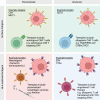Antigenic targets in clear cell renal cell carcinoma
- PMID: 38014393
- PMCID: PMC10475986
- DOI: 10.3233/KCA-230006
Antigenic targets in clear cell renal cell carcinoma
Abstract
Immune checkpoint inhibitors (ICIs) have transformed the management of advanced renal cell carcinoma (RCC), but most patients still do not receive a long-term benefit from these therapies, and many experience off-target, immune-related adverse effects. RCC is also different from many other ICI-responsive tumors, as it has only a modest mutation burden, and total neoantigen load does not correlate with ICI response. In order to improve the efficacy and safety of immunotherapies for RCC, it is therefore critical to identify the antigens that are targeted in effective anti-tumor immunity. In this review, we describe the potential classes of target antigens, and provide examples of previous and ongoing efforts to investigate and target antigens in RCC, with a focus on clear cell histology. Ultimately, we believe that a concerted antigen discovery effort in RCC will enable an improved understanding of response and resistance to current therapies, and lay a foundation for the future development of "precision" antigen-directed immunotherapies.
Keywords: Renal cell carcinoma; T cell receptor; cancer vaccine; chimeric antigen receptor T cell; neoantigen; tumor antigen.
© 2023 – The authors. Published by IOS Press.
Conflict of interest statement
D.A.B. reports honoraria from LM Education/Exchange Services, advisory board fees from Exelixis and AVEO, equity in Fortress Biotech (subsidiary), personal fees from Schlesinger Associates, Cancer Expert Now, Adnovate Strategies, MDedge, CancerNetwork, Catenion, OncLive, Cello Health BioConsulting, PWW Consulting, Haymarket Medical Network, Aptitude Health, ASCO Post/Harborside, Targeted Oncology, AbbVie, and research support from Exelixis and AstraZeneca, outside of the submitted work. N.R.S has no conflict of interest to report.
Figures


Similar articles
-
Revisiting mechanisms of resistance to immunotherapies in metastatic clear-cell renal-cell carcinoma.Cancer Drug Resist. 2023 May 30;6(2):314-326. doi: 10.20517/cdr.2023.09. eCollection 2023. Cancer Drug Resist. 2023. PMID: 37457132 Free PMC article. Review.
-
Effective personalized neoantigen vaccine plus anti-PD-1 in a PD-1 blockade-resistant lung cancer patient.Immunotherapy. 2023 Feb;15(2):57-69. doi: 10.2217/imt-2021-0339. Epub 2023 Jan 18. Immunotherapy. 2023. PMID: 36651232
-
Case Report: Successful treatment of late-onset immune checkpoint inhibitor-associated membranous nephropathy in a patient with advanced renal cell carcinoma.Front Immunol. 2022 Jul 28;13:898811. doi: 10.3389/fimmu.2022.898811. eCollection 2022. Front Immunol. 2022. PMID: 35967405 Free PMC article.
-
Understanding the Tumor Immune Microenvironment in Renal Cell Carcinoma.Cancers (Basel). 2023 Apr 27;15(9):2500. doi: 10.3390/cancers15092500. Cancers (Basel). 2023. PMID: 37173966 Free PMC article. Review.
-
Characterization of outcomes in patients with advanced genitourinary malignancies treated with immune checkpoint inhibitors.Urol Oncol. 2021 Jul;39(7):437.e1-437.e9. doi: 10.1016/j.urolonc.2021.01.006. Epub 2021 Jan 23. Urol Oncol. 2021. PMID: 33495117 Free PMC article.
Cited by
-
Alternative Splicing in Tumorigenesis and Cancer Therapy.Biomolecules. 2025 May 29;15(6):789. doi: 10.3390/biom15060789. Biomolecules. 2025. PMID: 40563429 Free PMC article. Review.
-
Hot Spots in Urogenital Basic Cancer Research and Clinics.Cancers (Basel). 2025 Mar 31;17(7):1173. doi: 10.3390/cancers17071173. Cancers (Basel). 2025. PMID: 40227699 Free PMC article. Review.
References
-
- Demasure S, et al.. Overall survival improvement in patients with metastatic clear-cell renal cell carcinoma between 2000 and 2020: a retrospective cohort study. Acta Oncol. 2022;61(1):22–9. - PubMed
-
- Rini BI, et al.. Pembrolizumab plus Axitinib versus Sunitinib for Advanced Renal-Cell Carcinoma. N Engl J Med. 2019;380(12):1116–27. - PubMed
-
- Motzer R, et al.. Lenvatinib plus Pembrolizumab or Everolimus for Advanced Renal Cell Carcinoma. N Engl J Med. 2021;384(14):1289–300. - PubMed
Publication types
LinkOut - more resources
Full Text Sources
